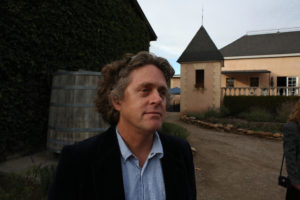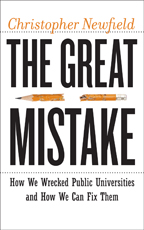 This week Full Stop marks the beginning of another school year with a two-part interview with Christopher Newfield, one of the most prescient and active commenters on contemporary higher education. In a trio of books — Ivy and Industry, Unmaking the Public University, and the recently published The Great Mistake: How We Wrecked Public Universities and How We Can Fix Them — Newfield tells one the great stories of the American democratic project, the development and undoing of the public university system. Like any great American tale it is riven with contradictions, riding a productive line between promise and tragedy, far-sighted leadership and the folly of our pettiest forms of politics.
This week Full Stop marks the beginning of another school year with a two-part interview with Christopher Newfield, one of the most prescient and active commenters on contemporary higher education. In a trio of books — Ivy and Industry, Unmaking the Public University, and the recently published The Great Mistake: How We Wrecked Public Universities and How We Can Fix Them — Newfield tells one the great stories of the American democratic project, the development and undoing of the public university system. Like any great American tale it is riven with contradictions, riding a productive line between promise and tragedy, far-sighted leadership and the folly of our pettiest forms of politics.
Perhaps the most important feature of Newfield’s work is to re-embed discussions of higher education in the broader field of political contestation and to provide it with a healthy dose of historicizing. This seems like an obvious point, but the preponderance of current scholarship — whether it is the optimistic reform camp in the embrace of a techno-managerialism or the critical camp that laments a perceptible decline in campus culture — isolates the university from the ongoing project of democracy (“multi-racial mass democracy” in Newfield’s terms) and the many threats it now faces. I spent several years researching “crisis of the university” literature and when people would try and press me towards either of these poles I could often do no better than point to Newfield as providing the paradigm most appropriate to the subject.
Christopher Newfield is a professor of Literature and American Studies at the University of California–Santa Barbara. He helps run Remaking the University, one of the best forums for contemporary higher education debates, and has recently launched a Critical University Studies book series at Johns Hopkins Press with his co-editor Jeffrey J. Williams.
In this first installment we discuss the role of the humanities in the contemporary university, the need to foster a culture of self-governance to counter the onslaught of managerialism amongst the administrative ranks, and how the creeping ethos of privatization undermines the democratic ethos that gave rise to the public university. Our second installment can be found here.
Michael Schapira: I first turned to your work because I was very dissatisfied with apologies for the humanities in universities. People often seemed happy to “recite the humanist credo,” as Chad Wellmon and Paul Reitter so aptly put it, and feel that the inherent worth of their pursuits would halt the consistent marginalization of their departments. In Unmaking the Public University in particular you introduced politics, history, race, and something that you develop at great length in The Great Mistake, which is the difference between a social (non-market) and private (market) benefit. In this book you vary your argumentative strategies, incorporating letters, conversations, policy analysis, and even examples from your classroom. Do you think humanists have been slow to adopt new language and new strategies as privatization has crept into nearly every corner of the university?
I don’t know how happy humanists are to recite a credo. But credos do assert beliefs that transcend institutions, and we seem to prefer to throw ourselves at the mercy of our institutions rather than try to run them. This has made the humanities fields poorer and less influential than they would be otherwise.
I tried to write The Great Mistake in a way that would allow readers to think about their own experience and work back to institutional and financial forces from there. More on that in a bit.
The problem with assertions of inherent value of any discipline is that they are professions, and the value of any profession exists only in relation to its institutions. Your value isn’t as good as your credo, it’s as good as your self-governance — your self-governance as a knowledge community. Professions were built around the superiority of intellectual home rule to external management. The most famous (and militant) explication was [Thorstein] Veblen’s Higher Learning in America (1918), which relentlessly detailed why researchers need to protect their work from “the business mind.” Professions exist because a discipline’s self-understanding exists through its institutions. The wider culture will grasp and respect a discipline in proportion to the strength of its institutional practices. VeblPerformativity rests in self-governance, not utterance.
Science and technology faculty know these things and are very involved in shaping their workplaces. They know they can’t do their jobs without their institutions — federal agencies, offices for contracts and grants, procurement and budgeting units, technical advisory boards, deans and vice-presidents of research — and many of them have industry backgrounds and direct experience with complex research management. STEM faculty are particularly active in university governance. They also have senior managers over a reputation barrel in a way humanities faculty do not.
STEM faculty are right that there’s no pathway to public support that doesn’t lead through their universities. Humanities faculty may think that we can go directly to the public by writing more accessibly and then getting a book review published in a big newspaper, magazine, or popular website. But in these cases we are reaching them as a book reviewer, not as a professional humanist. The latter needs to become a much more visible social identity, and that can only be articulated by making universities into sites of professional self-governance. At the moment, most of them are not.
Austerity has been pushing humanities faculty away from self-governance and towards accepting the university as a patronage system. Extramural funding for collaborative research is nearly nonexistent (less than one percent of total federal R&D funding goes to the arts and humanities). This means that humanities scholars, as usual, depend disproportionately on internal university funding. Internal funding has always been devoted largely to backfilling losses on STEM research, and that problem is even worse now. So most direct internal funding for the humanities will come through individual faculty deals with chairs and deans through recruitment, retention, and projects of interest to the administration (ones that might attract donors, or the Mellon Foundation).
It breaches decorum to point out that the unspoken precondition for such funding is not criticizing or challenging the internal funder — the chair, dean, etc. And yet the absence of a capacity for criticism blocks shared governance, to say nothing of self-governance. Clients in patronage systems have a material interest in ignoring inequities or abuses in order to stay in the good graces of key officials. They tend to shy away from colleagues who have engaged in critique and been labeled controversial. Faculty have epistemological standpoints that are marginalized by the moving of decision rights up the management ladder. That creates the knowledge asymmetries that underwrite “epistemic injustice.” As patronage replaces professional self-governance, humanities departments are unable to come into political existence in Hannah Arendt’s sense. That keeps them institutionally weak, which in turn weakens their public claims.
We talk a lot about the limits of critique. I’m more worried about the absence of critique. I mean institutional critique, including self-critique. That’s how professions get out of blind alleys and advance. If we want the humanities to be healthy, we’re going to have to build professional democracy in universities.
On the question of style: the humanities fields are generally anti-reductionist and synthetic. We see specific experience, affective responses, and personal interactions to be as relevant as cash flows and invention disclosure regulations. In the book, I try to reflect the interconnectedness of our hybrid institutional-intellectual lives by using different materials and modes of address. I’m obsessed with having a solid empirical base, but also with a more diverse empiricism. I tried to combine ideas, institutions, and characters in the way that they actually interact.
In the concluding section of you relay a conversation with an Education School Dean who is frustrated that you can’t give him five policies that will fix public higher education. You respond by arguing, “the book is not only about policy errors but about the framework or paradigm that enables them.” In the Kuhnian sense the current paradigm of privatization is no longer very helpful in solving the problems of mass education, and moreover is producing all kinds of anomalous situations it cannot solve — spiraling tuitions, decreasing resources for instruction, administrative bloat, and humanities and arts programs subsidizing STEM research, to name just a few from the book. Max Planck once said, “A new scientific truth does not triumph by convincing its opponents and making them see the light, but rather because its opponents eventually die, and a new generation grows up that is familiar with it.” Gramsci said, “The crisis consists precisely in the fact that the old is dying and the new cannot be born; in this interregnum a great variety of morbid symptoms appear.” Do you think that in some ways many of these problems in higher education will only be resolved when a new generation initiates some self-conscious break with the current paradigm? Has an uptick in student activism signaled that there are hopeful signs on this front?
Yes on all counts.
First let me say upfront that I’m motivated by my dual sense that English-speaking societies have become post-democratic (Colin Crouch’s term), while the current “knowledge economy” no longer requires a large middle class. Most knowledge workers are heading towards “cognotariat” status. The adjuncting of university instruction is Exhibit A.
We can have post-democratic capitalism without mass-scale, high-level public universities, and current or increasing levels of dysfunction, including growing precarity and racialized violence. But turmoil and decline will accelerate if we don’t cultivate intelligence across the entire population. We can’t solve our core problems, including society’s deficient intellectual processes, without mass access to really high-quality university-level learning. I don’t want to make apocalyptic statements about the coming neofeudalism, but in the U.S. (and the U.K.) we’re not yet smart enough to succeed as a society under the new conditions. Universities have a critical role to play in providing mass quality learning and research. Our university system isn’t there, and the book is about how we’ve been going in the wrong direction.
Students have had to address the university’s big problems largely by themselves. This is because most university leaders are stuck in “the Long 90s,” tenure-track faculty are on the sidelines, and commercial vendors and TV personalities can say whatever nutty stuff they want.
Let me say what I mean by the old, 90s paradigm. It comes from the Bill Clinton-Tony Blair compromise with Reagan-Thatcher in the public sector. This “third way” assumed that public services — urban transportation, electricity, trash removal, fire protection, or public higher education — had no special feature that couldn’t be improved with private-sector techniques and private capital. We could reinvent universities in the same way that we were supposed to “reinvent government” — by introducing corporate management techniques, drive educational goals with accounting, seek private gifts and investment, emphasize return on investment, transfer technology to business, and empower boards of trustees to define the university brand.
The Great Mistake shows that the private sector hurt rather than helped the public sector. Some of the problems are financial. The private sector gets subsidizes from public universities — I go into detail about this. Students pay more tuition than they can afford and go into excessive debt; many are homeless or hungry while enrolled in school.
Other problems are educational and social. They are destructive and concrete: I got into the subject not through philosophical critique of private-public partnerships but through faculty senate planning and budget committees, where I saw the financial problems first hand.
I do think it rises to the level of crisis in Gramsci’s sense. As one symptom, nearly everyone now agrees that the U.S. middle class is in crisis. That’s tied to the crisis of the middle class’s formative institution, the public university. Another symptom is racial division and white racial resentment. Many whites believe that people of color have stolen their mobility, scapegoating them rather than looking at their own choice to defund formative public institutions.
In the book I make a causal connection between the Clintonist 90s paradigm and the ensuing damage. Applying private-good models to a public good like higher education doesn’t make it more efficient — it wrecks it. Public goods require the widest possible consumption of the best available version: if St Paul’s sewers work and Minneapolis’s don’t, St Paul also gets sick. If three percent of college students get Stanford-style quality and the rest get a cheap imitation, Stanford grads are hurt by lower general intelligence. In order to develop the best possible version of a service and make it universal, public goods cannot be rationed by price, that is, by people’s ability to pay. (To use economics jargon, we must start to treat these goods as “non-excludable” and make them “non-rivalrous.”)
Universities are generally run by well-intentioned, capable people who came up in this New Democrat (and New Labour) paradigm that assumed the private sector was adding efficiency and new revenue streams to public goods. This is “the great mistake” of the title — to apply private-sector goals and practices to universities that should logically be treated as public goods.
The book moves through six big problems that ensue for universities along with one giant problem for society. Together these problems reinforce each other and create a devolutionary cycle that has gotten us into the predicament we’re in now: lower quality of overall education, reduced social benefits, and weaker university finances. You’d think booming student debt and instructional corner-cutting would at least help the university’s bottom line. But instead we get a lose-lose-lose situation.
Students have been protesting a core feature of this model for ten years — tuition that goes up faster than inflation, and that generates constantly growing debt. They directly experience the model’s failure. The model claimed that if students treated university attendance as an investment in private market returns — a better salary — they would make their investment back with plenty to spare. Instead, the private-sector paradigm has made debt a central economic fact of the first ten or twenty years in the life of today’s typical college grad. It has encouraged many to move back home instead of into the world, and pushed others into jobs they don’t actually like. Graduate underemployment remains a problem eight years into the recovery.
This is how the devolutionary cycle works: one trend — universities addressing their revenues by ramping up tuition and debt — had a multiplier effect on another — the corporate world reducing the long-term stability and benefits of middle-class jobs. As graduates asked, “debt for what?” they also looked into deeper problems with the model.
The paradigm began to change via the anti-tuition student protests in 2009, which fed into the Occupy movement, and which were fanned from different directions by Strike Debt and Black Lives Matter. Bernie Sanders came after the groundwork had been lain. He was the first national politician to say again and again that the system is broken. In the 2014 midterm elections, free college was a crazy idea. Two years later, free college became a major plank of the Democratic party platform. Seeing the issue’s popularity, New York governor Andrew Cuomo has implemented sort-of free college in that state, Tennessee is working with an interesting variant, and the issue remains on the agenda. Since Obama-era tweaks of the old paradigm did nothing to stop the growth of student debt, pressure to replace “high-tuition/high aid” will continue to grow.
The same thing is happening in the UK. On the heels of the financial crisis, the Cameron government tripled the university fee cap to £9000 while zeroing out central funding for most subjects. As a result, U.K. graduate debt now averages an incredible £50,000 (vs $37,000 in the US, though UK repayment is contingent on income). The Tory funding model is now widely disliked and a few mainstream pundits are saying that English universities will soon be free.
Anti-fees sentiment isn’t just trying to lower price but to change the paradigm. Labour party leader Jeremy Corbyn ran in 2017 on a promise not only to “scrap fees” but to create a National Education Service in which all education, from preschool to university to adult learning, would be “free at the point of service.” The popularity of this idea was a major reason why Labour took an unexpectedly big bite out of the Conservative majority in the June 2017 election.
When he talks about social crises, Gramsci is both depressing and inspiring. He’s depressing in his honesty about how insanely hard it is to change a hegemonic system that is entrenched through the consent of many diverse groups. He’s inspiring in saying so clearly that this hegemony needs to be recreated every day or it starts to fall apart.
One way of viewing the university’s decline cycle is as a set of anomalies that threaten the old paradigm. In the book, I show that scientific research does not make money for the university. Philanthropy can’t replace lost state funds. Public funding does not recover along with the economy. Financial aid does not protect low-income students from tuition and debt. Ed-tech does not deliver as good or better quality at a lower price. Open-access colleges do not provide education that’s equivalent to that at selective colleges. Contemporary capitalism does not reward productivity increases with proportionately increased wages. The anomalies are adding up, and it’s the rising generation that is working on a better system for dealing with them.
Although I think real university change will require a mass social movement, I hope my book can help keep university administrations from digging in on the wrong side.

This book does not succumb to what your series co-editor Jeffrey J. Williams has called “ideas discourse,” which focuses on the history of ideas about the university as opposed to the variegated history of the institution itself. However ideas do seem to loom large in your work, and I wonder how much big ideas from the past can help us work through the present moment. In particular I am thinking about the California Master Plan, a signal achievement in public higher education for investing in the human capital of a population. I’m also thinking of the “Wisconsin Idea,” a high-water mark for the progressive movement in making sure universities worked to the broad public benefit, and an idea Scott Walker attempted to remove from the State University Mission Statement in 2015. I could add General Education in a Free Society, whose commitment to mass education I see you drawing upon, or Vannevar Bush’s Science – The Endless Frontier which guaranteed high levels of federal funding for basic as opposed to applied research. Do you think we have the resources from within our own tradition to move away from the privatization paradigm? Are the broad outlines of policies there or have the conditions of higher education changed too much to draw heavily from this history?
One I’ve already mentioned: professionalism, which has lost most of the battles with managerial forces and needs a revival. Medicine is the most important case, but the academic disciplines are also important.
A second is human capital theory, properly humanized. This has been largely ignored by the Left, which has been a gift to the Right: the Right has been able to define most of the rules for which human development is worthwhile and why it generally should not be publicly supported. The basic idea is profoundly humanistic and progressive, with strong elements of the early Marx: the economy and society only work if the educational system develops personal capabilities to something like each person’s limit. U.S. captains of industry once supported free public college when they thought their workforces and profits depended on it. They have quietly changed their mind about this — they want elite professional services in limited numbers, and many sectors don’t really know what to do with all the other graduates. Educators and the political left should rethink human capital theory for the current situation, and oblige the political system to put it to use.
A third resource is the diffuse idea of what I’ve been calling mass quality. It is an implicit egalitarianism of service: though you don’t need the same grades to get into state college that you need to get into the University of Michigan at Ann Arbor, the level and value of the instruction would be similar. This has been more an assumed practice than a principle. It is violated by today’s huge differences in per-student expenditure, with generally more affluent and better-educated students going to richer campuses and getting two or three or even ten times the per capita expenditure of students at poorer schools. The public did not vote for the gross inequality that we now have, but assumed that tax dollars would be fairly spent on giving everyone a roughly similar educational chance. This is a mainstream middle-class default assumption that held up for a long time among whites. Just as political pressure was belatedly extending it to people of color, right-wing policy kicked off the inequality boom, whose problems are now obvious and regretted even among most Republicans. Universities can use the ethics of educational equality to much better effect.
The most important historical resource consists of the multitude of civil rights movements. The struggle for educational equality has been central to Black civil rights from at least the 18th century. Not only does that struggle continue, but inspiration and practical lessons also come from anti-war, anti-imperial, feminist, farmworker, and other movements. The strength of the post-war university was the fusion of academic knowledge and the direct, complicated experience these movements brought to campuses in new ways. The last few years has seen a revival not only of anti-racist movements on campus, inspired in part by Black Lives Matter, but of feminism in part around protests against the prevalence of sexual assault, and queer and trans movements. Many student activists are also critiquing the autocratic practices of senior administrators as it affects the outcome of primary issues.
We’re in the middle of a period of continuous campus mobilization and ferment, and it’s going to take us to interesting places.
One of the major features of privatization is to push the key issue out of view. We focus on the gross number of research dollars brought in by faculty and not on how sponsored research is a loss for universities and often has SASH disciplines (Social Science, Arts, and Humanities) subsidizing STEM disciplines. We measure budgets against everything but actual investment in classroom instruction. We focus on donations, industry partnerships, and philanthropy when this is such a marginal part of the budget compared to state funding and tuition dollars. In essence privatization is about making certain aspects of the university invisible. I’ll sound a bit like the Dean you talk to at the end of the book, but what are two things that you think immediately need to be brought back out into the light?
The university’s key weakness in the policy world is that we can’t explain “why college costs so much.” One growing cost is student services, which helps students succeed but that needs to be explained. Much cost growth goes into increasing “quality of care” as it does in medicine. It’s not just ripping off students or the public — it’s supporting and teaching better. So not all new costs can be traced back to what I call in the book the “price of privatization.”
The hidden cost that most needs to be part of public policy debate is research subsidies. Outside sponsors of research oblige universities to subsidize them, meaning universities lose money. Universities have to spend 19 cents of their own money to support a dollar of sponsored research, and public universities spend closer to 25 cents on the dollar. (I explain the complications behind these headline numbers in the book.) Some of this is legitimate cost-sharing between the states and the federal government. Most of it is the sponsor — private corporations, philanthropies, state and federal agencies — forcing universities to take a loss so they can save money themselves. The Gates Foundation caps overhead payments at around 10 percent when actual university overhead is closer to 70 percent.
Universities subsidize others in part because their faculty demand it, and in part because they are the politically weaker party. My argument is that they are weaker because they seem to be hiding something — the shame of losing money in a private-good framework. If they advocate for a public good framework that legitimates having their expenses fully covered or shared fairly as part of a public partnership, they would be in a better political position. They would also be able to spend more money on buying down tuition or some other similar social good.
Philanthropy also has downsides, including universities having to spend their own money to support “gifts,” and also damage to academic freedom when donors control content or ideology of beneficiaries, crudely (Koch Brothers) or subtly.
Privatization creates subsidies, inefficiencies, and also public disinterest. To the extent that a university becomes what Elizabeth Anderson calls “private government,” most people don’t trust them and don’t want to pay for them.
The deeper discussion needs to be about the faulty ethics of privatization, particularly in a struggling democracy that needs public goods to thrive.
I teach undergraduate philosophy and composition and found a lot in your reading of Academically Adrift. “’Limited learning’ is a problem alright — in practical majors. In traditional liberal arts and science majors, students learn fairly well. That was the most grossly under-reported finding in the book.” Distressingly, 70% of undergraduate instruction is done by contingent faculty (I am one of them) who don’t have the resources to adequately provide liberal arts instruction (in one class I had 37 students so had to give multiple choice exams in a philosophy course, which distorts the course material), so ultimately you think limited learning is “a resource problem.” I couldn’t agree more. But I also see these students getting a lot of dangerous counter programing from practical majors, which have very different educational goals. For the sake of argument let’s say we can fix the resource problem by compensating contingent faculty adequately. Do you think there is a larger problem in adding all of these practical majors, which American universities have done in the past 30 years?
Yes! First, practical majors give students more limited cognitive skills. The reason is fairly simple: the same study that newspapers cited as proving that colleges don’t teach students anymore actually showed that students learn well by doing some basic things: for example, having individual contact with a professor; studying more than the current norm of 12-13 hours a week; and taking hard courses, meaning courses where they read more than 40 pages a week and write more than 20 pages a term. Vocational courses seem to cut back on the basic activities that lead to cognitive gain.
Second, we’ve miseducated students about education. We overemphasize pseudo-objective learning assessment via testing. We claim a connection between some set basket of info and a good job. We don’t teach the winding road of learning how to learn, the struggle for cognitive gain, the back and forth between content and skills and between data and interpretation. Learning how to learn should be part of every major and form at least a small part of every course.
Society needs people who can interpret ambiguous information under conditions of uncertainty. It needs people who can define problems accurately, figure out what they don’t know, construct a project that can find those things out. They need pursue a project that has dozens of steps, and persist through the doubts and even the open hostility of others. Society needs people who can work without orders, and figure out new rules on their own and with others. We’re not going to survive as a society if we rely on a 2 percent or 10 percent elite to do the creative work. We need mass creativity, and our universities have to be structured to deliver this.
Michael Schapira is an Interviews editor at Full Stop and teaches Philosophy at Hofstra University.
This post may contain affiliate links.







